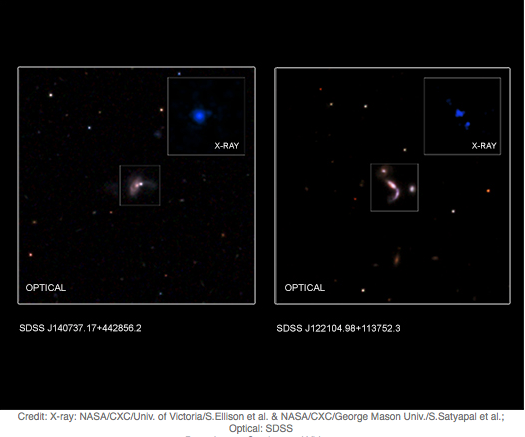
Super Supermassive Black Holes (SMBHs) are formed by galaxy collisions and usually reside at the centre of the galaxies. Most, if not all galaxies, host a SMBH. Single SMBHs have been detected all over the universe, but dual SMBHs have been difficult to find. Less than ten confirmed pairs of growing black holes were known from X-ray studies so far, based mostly on chance detections. Now astronomers used a novel method to identify five more pairs!
First, optical data from the Sloan Digital Sky Survey (SDSS) were used to identify galaxies that appeared to have undergone a recent merger. From these data, scientists selected sources with separation less than 30, 000 light years and using infrared colors from the Wide-Field Infrared Survey Explorer (WISE) they chose those that were hosting a rapidly growing SMBH. This analysis revealed seven merging systems. Since growing SMBHs strongly emit in X-rays they used the X-ray satellite Chandra, to observe these sources. Chandra showed that five systems host pairs of X-ray sources, providing evidence that they contain two growing SMBHs!
These results could shed light on how black holes grow and have also implications on the field of gravitational waves. Using the Laser Interferometer Gravitational-Wave Observatory (LIGO) and the VIRGO interferometer, astronomers have detected the signals of merging black holes, but these are stellar black holes, weighing about eight and 36 times the mass of the Sun. SMBHs, on the other hand, weigh millions of times the mass of the Sun. When the aforementioned detected pairs of SMBH come even closer together, they will merge into a single even bigger black hole. During this process an enormous amount of energy will be released, as mass is converted into gravitational waves.
Studying pairs of Supermassive Black Holes, will allow us to understand how common these systems are and therefore predict the signals from gravitational waves. A new era in exploring the universe begins.
Publications: Satyapal et al. 2017, Ellison et al. 2017
Source: Chandra
